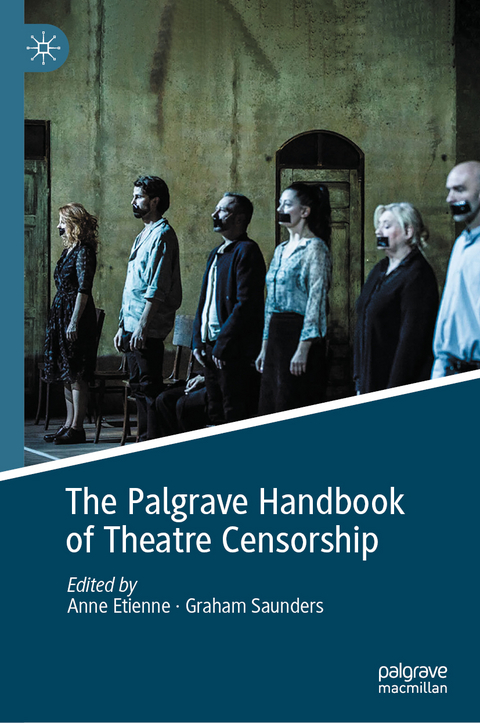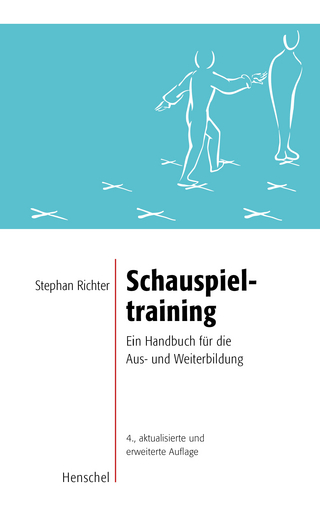
The Palgrave Handbook of Theatre Censorship
Springer International Publishing (Verlag)
978-3-031-67298-9 (ISBN)
- Noch nicht erschienen - erscheint am 13.01.2025
- Versandkostenfrei
- Auch auf Rechnung
- Artikel merken
This book incorporates a wide theoretical, cultural, literary and historical engagement in exploring the tension between dramatic productions and the forms of censorship they encounter from creation to reception. The Palgrave Handbook of Theatre Censorship offers global new insights into censorship practices, examining attempts at repression motivated either by fears that audiences gathering together to watch live dramatic events will lead to sedition and mass uprisings, or by moral or religious squeamishness requiring the establishment of institutional systems of censorship to curb or suppress the stage. As such, the Handbook aims to initiate redefinitions of what we understand or experience as censorship.
Who knew theatre could (still) carry so many threats, or be so widely provocative and dangerous? This is an extraordinary and often eye-opening set of thirty-six individually insightful, wide-ranging and oftentimes disturbing essays, each of which offers unique insights into theatre censorship practices and their impact within a specific political and moral culture. There is a particular emphasis on the recent and current, and the authors speak with first-hand knowledge and from direct experience not only about the restrictions but also how artists sometimes negotiate and evade these. What makes the book so especially fascinating and illuminating is seeing so many examples juxtaposed together. This enables the reader to hear the essays and the cultures talking to and alongside each other. The collection repeatedly breaks fresh ground, and the editors deserve enormous credit for gathering and effectively curating so many reports from the front-line.
- Steve Nicholson, Emeritus Professor, University of Sheffield, UK
Anne Etienne and Graham Saunders's book is a wide-ranging, incisive and compelling collection of reflections and case studies on the theatre industry's relationship to censorship and self-censorship from a historical and contemporaneous perspective. An impressive array of authors have been assembled for this volume representing, among them, views on the subject from Spain, Denmark, Norway, Zimbabwe, South Africa, Germany, Italy, Indonesia, Iran, Portugal, Turkey, Brazil, Japan, Ireland, Australia, Russia, England and more. The book is by turns surprising in its curatorial and narrative design and wonderfully effective at delineating the complex and thorny paths that create socio-political cultures where the censorship and self-censorship of theatre artists thrives and/or is efficaciously contested and rebelled against. Of note is a through line of argument in the book around less overt modes of surveillance that police artists' imaginations and thereby the work they create and produce. At a time in the world where many governments are increasingly seeking to limit artistic expression, this book is a necessary reminder of the many freedoms that have been fought for in theatres around the globe, and how the power of being unsilenced must never be taken for granted.
- Caridad Svich. Playwright & Translator
This is a truly excellent collection of incisive studies. It is wide-ranging, impressively global in scope, with an illuminating balance of the historical and the contemporary. In its impressive and well-realised ambition, demonstrated by the well-focused intelligence and academic flair of its many contributors, this collection is both magisterial and vital. It is an essential contribution to censorship studies, fascinating and inspiring, a must-read for anyone interested in the subject.
- Aleks Sierz. Theatre critic and author of Rewriting the Nation: British Theatre Today (2011) & Good Nights Out: A History of British Theatre Since the Second World War (2021)
Anne Etienne lectures in Modern and Contemporary Drama in the School of English and Digital Humanities, University College Cork, Ireland. Her research focuses on theatre censorship, Arnold Wesker and contemporary Irish theatre. She has authored essays on these topics for international journals and collective volumes. Her publications include Theatre Censorship: from Walpole to Wilson (2007), and the co-edited volumes Populating the Stage: Contemporary Irish Theatre (2017), Arnold Wesker: Fragments and Visions (2021), Adult Themes: British Cinema and the X Certificate in the Long 1960s (2023), and Theatre Censorship in Contemporary Europe: Silence and Protest (2024). She is co-editor of the series Palgrave Studies in Cultural Censorship.
Graham Saunders is the Allardyce Nicoll Chair of Drama in the Department of Drama and Theatre Arts at the University of Birmingham, UK. He is author of Love me or Kill me: Sarah Kane and the Theatre of Extremes (2002), About Kane: the Playwright and the Work (2009), Patrick Marber's Closer (2008), British Theatre Companies 1980-1994 (2015), Elizabethan and Jacobean Reappropriation in Contemporary British Drama: 'Upstart Crows' (Palgrave Macmillan, 2017), and Harold Pinter (2023). He is co-editor of Cool Britannia: Political Theatre in the 1990s (2008); Sarah Kane in Context (2010) and Arnold Wesker: Fragments and Visions (2021). He is co-series editor for Modern and Contemporary Dramatists - Stage and Screen and the Palgrave Studies in Cultural Censorship.
1.Theatre Censorship: an Unceasing (un)Official Menace? .- 2.Theatre Censorship in New Spain in the 17th-18th centuries.- 3.Theatre Censorship in Restoration London: The Case of Charles Killigrew, Master of the Revels .- 4.Theatre Censorship in the Age of Liberty? The Case of the French Revolution .- 5.Manoeuvering in Contested Space: Theatre-makers under Censorship in Early Nineteenth-Century Germany .- 6.Theatre Censorship in Denmark and Norway.- 7.The Catholic Church vs. the Quebec Theatre (1859-1914) .- 8. Cultural Conflict and Versions of Censorship in Post-Reformation Scottish Theatre .- 9. Theatre Censorship in Nazi Germany .- 10. Ideological Surveillance, Censorship and Retaliation .- 11. Old and New Censorship in Contemporary Spanish Theatre .- 12. Staging Reconciliations and Rainbowisms: The Paradox of Censorship in South Africa and Zimbabwe .- 13. Theatre Censorship in the Maghreb (1990-present) .- 14. Theatre and Censorship: the Russian Case.- 15. Commedia dell'Arte: Born out of Censorship? .- 16. Censorship, Performance and Strange Places in Czechoslovakia (1948 - 1989) .- 17. Writing Under Pressure: Václav Havel, the Absurd, and the Politics of Censorship .- 18. Risky Business: Theatre Censorship in Postcolonial Indonesian Theatre .- 19. The 'rocade' in Rocado: navigating state censorship and La Francophonie in postcolonial Congolese theatre .- 20. In the Name of the Author: Samuel Beckett, Sarah Kane, and their Disputed Italian Productions .- 21. Dramaturgy of Constraint in Contemporary Iranian Theatre.- 22. The Detour Around Censorship: Private Theatres and Independent Performance Groups in Guangzhou, China .- 23. British Women Playwrights: Censorship and Self-censorship in the Romantic period .- 24. London's Grand Guignol versus The Lord Chamberlain: The Rise and Fall of a Troublesome Theatre .- 25. "A place where freedom of mind and spirit was possible": Black Theatre Makers and Censorship in Britain, 1900-1948.- 26.Conversion or Subversion: Homosexuality on the Portuguese Stage in Estado Novo Portugal.- 27.Theatre and Censorship Above and Within: Censorship and Self-Censorship in Israeli Theatre.- 28.Otherness and Censorship in the Theatre of Turkey (1960s-70s).- 29.A Paradigm of Populism: the Return to Censorship in Bolsonaro's Brazil.- 30.Censoring the Emperor: The Japanese Debut of The Mikado.- 31. "Censorship Made Me": And Censorship Created Mae West.- 32."Offending Australia's Returned Servicemen? Alan Seymour's The One Day of the Year and Censorship by Rejection.- 33. Moving Censorship: Memory and Reception in Allan McClelland's Bloomsday in Dublin, 1962.- 34. Soviet Censorship and Self-censorship: the Case of Gunars Priede.- 35.Kallol and the Incarceration of Utpal Dutt: State Repression, Censorship and the Struggle for 'National' History.- 36.Delusions of Safeguarding: Homegrown and Islamic State on the UK stage.- 37.Who Cancelled Robert Lepage? The "Noise and Silence" of Cancel Culture.
| Erscheint lt. Verlag | 13.1.2025 |
|---|---|
| Zusatzinfo | XV, 669 p. 4 illus., 1 illus. in color. |
| Verlagsort | Cham |
| Sprache | englisch |
| Maße | 155 x 235 mm |
| Themenwelt | Kunst / Musik / Theater ► Theater / Ballett |
| Schlagworte | Dictatorship • freedom of expression • Global censorship • History of Censorship • Propoganda • Repression • Self-censorship • State mechanisms • suppression • taboos • theatre censorship |
| ISBN-10 | 3-031-67298-4 / 3031672984 |
| ISBN-13 | 978-3-031-67298-9 / 9783031672989 |
| Zustand | Neuware |
| Haben Sie eine Frage zum Produkt? |
aus dem Bereich


